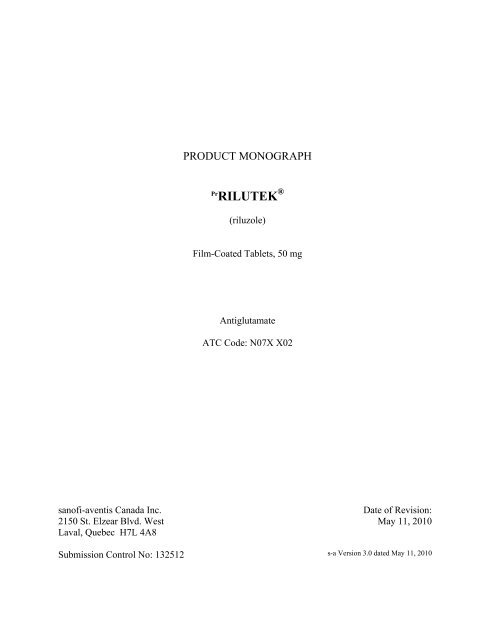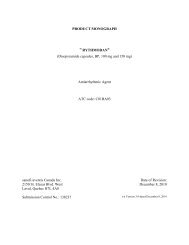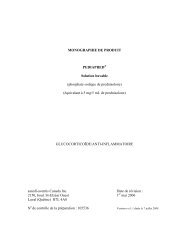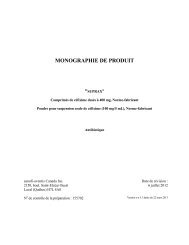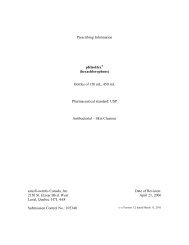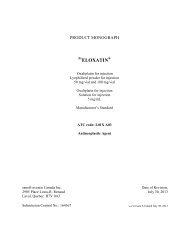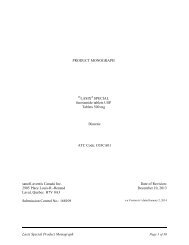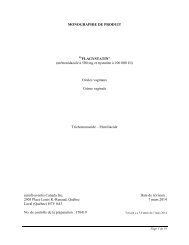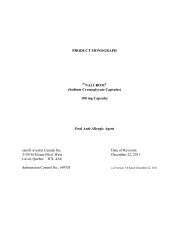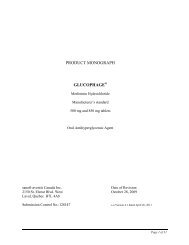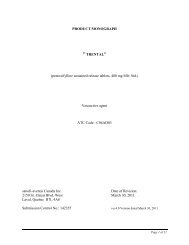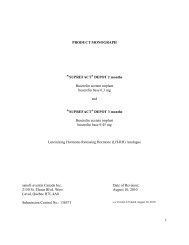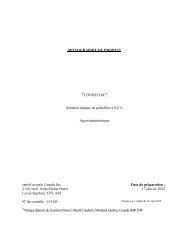Rilutek (riluzole) - Sanofi Canada
Rilutek (riluzole) - Sanofi Canada
Rilutek (riluzole) - Sanofi Canada
You also want an ePaper? Increase the reach of your titles
YUMPU automatically turns print PDFs into web optimized ePapers that Google loves.
PRODUCT MONOGRAPH<br />
Pr<br />
RILUTEK ®<br />
(<strong>riluzole</strong>)<br />
Film-Coated Tablets, 50 mg<br />
Antiglutamate<br />
ATC Code: N07X X02<br />
sanofi-aventis <strong>Canada</strong> Inc.<br />
2150 St. Elzear Blvd. West<br />
Laval, Quebec H7L 4A8<br />
Date of Revision:<br />
May 11, 2010<br />
Submission Control No: 132512 s-a Version 3.0 dated May 11, 2010
Table of Contents<br />
PART I: HEALTH PROFESSIONAL INFORMATION......................................................... 3<br />
SUMMARY PRODUCT INFORMATION................................................................................ 3<br />
INDICATIONS AND CLINICAL USE ..................................................................................... 3<br />
CONTRAINDICATIONS .......................................................................................................... 5<br />
WARNINGS AND PRECAUTIONS ......................................................................................... 5<br />
ADVERSE REACTIONS........................................................................................................... 9<br />
DRUG INTERACTIONS ......................................................................................................... 17<br />
DOSAGE AND ADMINISTRATION ..................................................................................... 18<br />
OVERDOSAGE ....................................................................................................................... 19<br />
ACTION AND CLINICAL PHARMACOLOGY.................................................................... 20<br />
STORAGE AND STABILITY ................................................................................................. 22<br />
DOSAGE FORMS, COMPOSITION AND PACKAGING ..................................................... 23<br />
PART II: SCIENTIFIC INFORMATION ............................................................................... 24<br />
PHARMACEUTICAL INFORMATION................................................................................. 24<br />
CLINICAL TRIALS ................................................................................................................. 25<br />
DETAILED PHARMACOLOGY ............................................................................................ 29<br />
TOXICOLOGY ........................................................................................................................ 31<br />
REFERENCES ......................................................................................................................... 33<br />
PART III: CONSUMER INFORMATION.............................................................................. 35<br />
Page 2 of 37
Pr RILUTEK ®<br />
(<strong>riluzole</strong>)<br />
PART I: HEALTH PROFESSIONAL INFORMATION<br />
SUMMARY PRODUCT INFORMATION<br />
Route of<br />
Administration<br />
Oral<br />
Pharmaceutical Nonmedicinal Ingredients (NMIs)<br />
Form/Strength<br />
Film-Coated Tablet/50 mg Core: anhydrous dibasic calcium phosphate,<br />
anhydrous colloidal silica, croscarmellose<br />
sodium, magnesium stearate, microcrystalline<br />
cellulose.<br />
Film Coating: hydroxypropyl<br />
methylcellulose, polyethylene glycol 6000,<br />
titanium dioxide.<br />
INDICATIONS AND CLINICAL USE<br />
RILUTEK (<strong>riluzole</strong>):<br />
• may extend survival and/or time to tracheostomy in some patients with amyotrophic lateral<br />
sclerosis (ALS).<br />
There is no evidence that RILUTEK exerts a therapeutic effect on motor function, lung function,<br />
fasciculations, muscle strength and motor symptoms.<br />
RILUTEK has not been shown to be effective in the late stage of ALS.<br />
Initially, RILUTEK should be prescribed only by physicians experienced in the diagnosis and<br />
management of ALS. If necessary, subsequent follow up and continuing treatment of the patient<br />
may be undertaken by non-specialized physicians, under the supervision of a specialist.<br />
The symptomatic management of patients with ALS is not changed by the addition of<br />
RILUTEK. Knowledge of the disease natural history and use of management strategies that<br />
assist the patient in coping with complications of the inevitable decline in motor power, such as<br />
non-invasine positive pressure ventilation (NIPPV), remain the most effective means to<br />
prolonging quality survival.<br />
Page 3 of 37
RILUTEK is not a cure for ALS, but a modest prolongation of survival represents a first step<br />
forward in treating ALS patients. No data exist to help predict how any individual patient will<br />
benefit from RILUTEK treatment. No evidence exists to define the duration of the benefit of<br />
continued RILUTEK use. Similarly, there is no evidence of additional benefit if RILUTEK were<br />
continued after tracheostomy is performed for ventilation.<br />
The following advisory recommendations are made:<br />
- ALS patients for whom Class I evidence suggests RILUTEK may prolong survival includes<br />
those who have:<br />
• definite or probable ALS by World Federation of Neurology (WFN) criteria (other<br />
causes for progressive muscle atrophy have been excluded)<br />
• symptoms present for less than 5 years<br />
• FVC >60% predicted<br />
• no tracheostomy<br />
- ALS patients for whom no Class I evidence supports the use of RILUTEK, but for whom<br />
there may be potential benefit includes those who have:<br />
• suspected or possible ALS by WFN criteria<br />
• symptoms present for more than 5 years<br />
• FVC 65 years): In controlled clinical trials, about 30% of patients were over 65. There<br />
were no differences in adverse effects between younger and older patients. A brief discussion<br />
can be found in the appropriate sections (See WARNINGS AND PRECAUTIONS, Special<br />
Populations, Geriatrics and ACTION AND CLINICAL PHARMACOLOGY, Special<br />
Populations and Conditions, Geriatrics).<br />
Pediatrics (< 18 years of age): The safety and efficacy of RILUTEK in any neurodegenerative<br />
disease occurring in children or adolescents have not been established.<br />
Page 4 of 37
CONTRAINDICATIONS<br />
RILUTEK is contraindicated in:<br />
- Patients who have a history of hypersensitivity reactions to <strong>riluzole</strong> or any of the tablet<br />
components. For a complete listing of the tablet components, see the DOSAGE FORMS,<br />
COMPOSITION AND PACKAGING section of the product monograph.<br />
- Patients who have hepatic disease or who have baseline transaminases greater than 3 times<br />
the ULN (upper limit of normal) (See WARNINGS AND PRECAUTIONS, General, Liver<br />
Injury / Monitoring Liver Chemistries; ACTION AND CLINICAL PHARMACOLOGY,<br />
Special Populations and Conditions, Hepatic Insufficiency; DOSAGE AND<br />
ADMINISTRATION, Special Population, Hepatic Insufficiency).<br />
- Patients who are pregnant or breast-feeding<br />
WARNINGS AND PRECAUTIONS<br />
General<br />
Liver Injury / Monitoring Liver Chemistries<br />
RILUTEK is contraindicated in Patients who have hepatic disease or who have baseline<br />
transaminases greater than 3 times the ULN (upper limit of normal) (See<br />
CONTRAINDICATIONS).<br />
RILUTEK should be used with caution in patients with a history of abnormal liver function, with<br />
known concomitant liver insufficiency or in patients with elevations in any of serum<br />
transaminase (ALT/SGPT; AST/SGOT), bilirubin, or gamma-glutamyl transferase (GGT) levels.<br />
Baseline elevations of several liver function tests (especially including elevated bilirubin) should<br />
preclude the use of RILUTEK ® (See CONTRAINDICATIONS; DOSAGE AND<br />
ADMINISTRATION, Special Populations, Hepatic Insufficiency; ADVERSE REACTIONS,<br />
Abnormal Hematologic and Clinical Chemistry Findings).<br />
Liver chemistries should be monitored in all patients on RILUTEK as the drug can increase<br />
serum aminotransferase, even in patients without a prior history of liver abnormality. Serum<br />
ALT levels should be measured every month during the first 3 months of treatment, every 3<br />
months during the remainder of the first year, and periodically thereafter (See WARNINGS<br />
AND PRECAUTIONS, Monitoring and Laboratory Tests).<br />
There were uncommon instances of jaundice and hepatitis.<br />
RILUTEK should be discontinued if the ALT levels increase to 5 X the ULN. There is no<br />
experience with dose reduction or rechallenge in patients who have developed an increase of<br />
Page 5 of 37
ALT to 5 X ULN. Readministration of RILUTEK to patients in this situation cannot be<br />
recommended. In cases of RILUTEK-induced hepatic injury manifested by elevated liver<br />
enzymes, the effect of the hepatic injury on RILUTEK metabolism is unknown (See ACTION<br />
AND CLINICAL PHARMACOLOGY, Special Populations and Conditions, Hepatic<br />
Insufficiency).<br />
Findings from Clinical Trials<br />
Experience in almost 800 ALS patients indicates that about 50% of RILUTEK-treated patients<br />
will experience at least one ALT/SGPT level above the ULN, about 8% will have elevations >3<br />
X ULN, and about 2% of patients will have elevations >5 X ULN. A single non-ALS patient<br />
with epilepsy treated with concomitant carbamazepine and phenobarbital experienced marked,<br />
rapid elevations of liver enzymes with jaundice (ALT 26 X ULN, AST 17 X ULN, and bilirubin<br />
11 X ULN) four months after starting RILUTEK; these returned to normal 7 weeks after<br />
treatment discontinuation.<br />
Maximum increases in serum ALT usually occurred within 3 months after the start of RILUTEK<br />
therapy and were usually transient when < 5 X ULN. In trials, if ALT levels were < 5 X ULN,<br />
treatment continued and ALT levels usually returned to below 2 X ULN within 2 to 6 months.<br />
However, treatment in studies was discontinued if ALT levels exceeded 5 X ULN; in these<br />
cases, the levels generally returned to less than 2 X ULN within 2 to 6 months.<br />
Carcinogenesis and Mutagenesis<br />
See the TOXICOLOGY, Mutagenicity section for the animal data.<br />
Hematologic<br />
Patients should be warned to report any febrile illness to their physicians. The report of a febrile<br />
illness should prompt treating physicians to check white blood cell counts and to discontinue<br />
RILUTEK in case of neutropenia (See ADVERSE REACTIONS, Abnormal Hematologic and<br />
Clinical Findings).<br />
Among approximately 5000 patients given RILUTEK for ALS, there were three cases of marked<br />
neutropenia (absolute neutrophil count less than 500/mm 3 ), all seen within the first 2 months of<br />
RILUTEK treatment. In one case, neutrophil counts rose on continued treatment. In a second<br />
case, counts rose after therapy was stopped. A third case was more complex, with marked<br />
anemia as well as neutropenia and the etiology of both is uncertain.<br />
Respiratory, Thoracic and Mediastinal Disorders<br />
Interstitial lung disease: Cases of interstitial lung disease have been reported in patients treated<br />
with RILUTEK, some of them were severe (See ADVERSE REACTIONS). If respiratory<br />
symptoms develop such as dry cough and/or dyspnea, chest radiography should be performed,<br />
and in case of findings suggestive of interstitial lung disease (e.g. bilateral diffuse lung<br />
Page 6 of 37
opacities), RILUTEK should be discontinued immediately. In the majority of the reported cases,<br />
symptoms resolved after drug discontinuation and symptomatic treatment.<br />
Hepatic/Biliary/Pancreatic<br />
See CONTRAINDICATIONS, WARNINGS and PRECAUTIONS, General, Liver Injury /<br />
Monitoring Liver Chemistries and Special Population, Hepatic Insufficiency, ACTION AND<br />
CLINICAL PHARMACOLOGY, Special Populations and Conditions, Hepatic Insufficiency;<br />
DOSAGE AND ADMINISTRATION, Special Population, Hepatic Insufficiency.<br />
Special Populations<br />
Pregnant Women:<br />
There are no adequate and well-controlled studies in pregnant women and RILUTEK is known<br />
to cross the placental barrier in rats. RILUTEK must not be used in pregnant women (See<br />
CONTRAINDICATIONS).<br />
In the pregnant rat, the transfer of 14 C-<strong>riluzole</strong> across the placenta to the foetus has been detected.<br />
Oral administration of <strong>riluzole</strong> to pregnant animals during the period of organogenesis caused<br />
embryotoxicity in rats and rabbits at doses of 27 mg/kg and 60 mg/kg, respectively, or 2.6 and<br />
11.5 times, respectively, the recommended maximum human daily dose on a mg/m 2 basis.<br />
Evidence of maternal toxicity was also observed at these doses.<br />
When administered to rats prior to and during mating (males and females) and throughout<br />
gestation and lactation (females), RILUTEK produced adverse effects on pregnancy (decreased<br />
implantations, increased intrauterine death) and offspring viability and growth at an oral dose of<br />
15 mg/kg or 1.5 times the maximum daily dose on a mg/m 2 basis.<br />
Nursing Women:<br />
In rat studies, 14 C-<strong>riluzole</strong> was detected in maternal milk. It is not known whether <strong>riluzole</strong> is<br />
excreted in human breast milk. Because many drugs are excreted in human milk, and because of<br />
the potential for serious adverse reactions in nursing infants from RILUTEK, RILUTEK must<br />
not be used in nursing women (See CONTRAINDICATIONS).<br />
Pediatrics (< 18 years of age):<br />
The safety and efficacy of RILUTEK in any neurodegenerative disease occurring in children or<br />
adolescents have not been established.<br />
Geriatrics (> 65 years):<br />
In controlled clinical trials, about 30% of patients were over 65. There were no differences in<br />
adverse effects between younger and older patients. Based on pharmacokinetic data, there are no<br />
special instructions for the use of RILUTEK in this population (See ACTION and CLINICAL<br />
PHARMACOLOGY, Special Populations and Conditions, Geriatrics).<br />
Page 7 of 37
Gender<br />
See ACTION and CLINICAL PHARMACOLOGY, Special Populations and Conditions, Gender<br />
Race<br />
See ACTION and CLINICAL PHARMACOLOGY, Special Populations and Conditions, Race<br />
Hepatic Insufficiency<br />
See CONTRAINDICATIONS; WARNINGS AND PRECAUTIONS, General, Liver Injury /<br />
Monitoring Liver Chemistries; ACTION AND CLINICAL PHARMACOLOGY, Special<br />
Populations and Conditions, Hepatic Insufficiency; DOSAGE AND ADMINISTRATION,<br />
Special Population, Hepatic Insufficiency.<br />
Renal Insufficiency<br />
RILUTEK is not recommended for use in patients with impaired renal function, as studies at<br />
repeated doses have not been conducted in this population (See DOSAGE AND<br />
ADMINISTRATION, Special Populations, Renal Insufficiency; ACTION AND CLINICAL<br />
PHARMACOLOGY, Special Populations and Conditions, Renal Insufficiency).<br />
Monitoring and Laboratory Tests<br />
Hepatic<br />
Because of risks of hepatitis and jaundice, serum transaminases, including ALT (SGPT) levels,<br />
should be measured before and during therapy with RILUTEK. Serum ALT levels should be<br />
measured every month during the first 3 months of treatment, every 3 months during the<br />
remainder of the first year, and periodically thereafter. Serum ALT levels should be measured<br />
more frequently in patients who develop elevated ALT levels (see WARNINGS AND<br />
PRECAUTIONS, General, Liver Injury / Monitoring Liver Chemistries).<br />
As noted in the WARNINGS AND PRECAUTIONS, General, Liver Injury / Monitoring Liver<br />
Chemistries section, there is no experience with continued treatment of patients once ALT<br />
exceeds 5 X ULN. If a decision is made to continue to treat these patients, frequent monitoring<br />
(at least weekly) of complete liver function is recommended. Treatment should be discontinued<br />
if ALT exceeds 10 X ULN or if clinical jaundice develops. Because there is no experience with<br />
rechallenge of patients who have had RILUTEK discontinued for ALT > 5 X ULN, no<br />
recommendations about restarting RILUTEK can be made.<br />
Blood Counts<br />
In the two controlled trials in patients with ALS, the frequency with which values for<br />
hemoglobin, hematocrit, and erythrocyte counts fell below the lower limit of normal was greater<br />
in RILUTEK-treated patients than in placebo-treated patients; however, these changes were mild<br />
and transient. The proportions of patients observed with abnormally low values for these<br />
parameters showed a dose-response relationship. Only one patient was discontinued from<br />
treatment because of severe anemia. The significance of this finding is unknown.<br />
Page 8 of 37
ADVERSE REACTIONS<br />
Adverse Drug Reaction Overview<br />
The most commonly observed adverse events associated with the use of RILUTEK, more<br />
frequently than with placebo treatment were: asthenia, nausea, elevations in liver function tests,<br />
dizziness, decreased lung function, diarrhea, abdominal pain, pneumonia, vomiting, vertigo,<br />
circumoral paresthesia, anorexia and somnolence.<br />
Approximately 14% (n = 199) of the 1396 individuals with ALS who received RILUTEK in<br />
clinical trials discontinued treatment because of an adverse event. Of those patients who<br />
discontinued due to adverse events, the most commonly reported associated adverse events were<br />
nausea, abdominal pain, constipation and ALT elevations.<br />
Hepatitis, anaphylactoid reaction, angioedema and pancreatitis have been reported in isolated<br />
cases.<br />
Clinical Trial Adverse Drug Reactions<br />
Because clinical trials are conducted under very specific conditions the adverse drug reaction<br />
rates observed in the clinical trials may not reflect the rates observed in practice and should not<br />
be compared to the rates in the clinical trials of another drug. Adverse drug reaction<br />
information from clinical trials is useful for identifying drug-related adverse events and for<br />
approximating rates.<br />
The events cited in the table below reflect all adverse experiences of ALS patients in placebocontrolled<br />
trials, treated with either RILUTEK at the recommended daily dosage of 100 mg/day<br />
or placebo, where the incidence with RILUTEK was numerically greater than placebo by at least<br />
1%.<br />
Page 9 of 37
Table 1 -Adverse Events Occurring in Placebo-Controlled Clinical Trials, for which the<br />
incidence with RILUTEK was ≥ 1% than placebo<br />
SYSTEM ORGAN CLASS<br />
Preferred Term<br />
<strong>Rilutek</strong> (100 mg/day)<br />
Studies 216, 301, 302<br />
(N=395)<br />
%<br />
Placebo<br />
Studies 216, 301, 302<br />
(N=406)<br />
%<br />
General disorders and Asthenia 17 11<br />
administration site conditions Pain 5 2<br />
Gastrointestinal disorders<br />
Nervous system disorder<br />
Nausea 14 9<br />
Abdominal pain 5 4<br />
Vomiting 4 2<br />
Paraesthesia oral 1 0<br />
Headache 7 6<br />
Dizziness 3 2<br />
Somnolence 2 1<br />
Cardiac disorders Tachycardia 3 2<br />
Hepatobiliary Disorders<br />
Alanine aminotransferase<br />
(ALT/SGPT) abnormal<br />
Aspartate aminotransferase<br />
(AST/SGOT) abnormal<br />
Gamma-glutamyltransferase<br />
(GGT) abnormal<br />
29 14<br />
23 19<br />
15 11<br />
Blood bilirubin abnormal 12 8<br />
Confirmatory Phase IV trial (study 401)<br />
Study 401 is an open-label Phase IV confirmatory trial conducted in <strong>Canada</strong>, consisting of a<br />
prospective treatment arm of n = 414 ALS patients treated with RILUTEK at the recommended<br />
daily dosage of 100 mg/day and a historical control arm for which there are no safety data.<br />
Patients treated with RILUTEK were instructed to report any events that occurred during the<br />
study. However, the investigators had to report only a) any events which required<br />
discontinuation of study drug and b) all serious adverse events, with the exception of events due<br />
to the progression of ALS, hospitalization for permanently assisted ventilation or tracheostomy<br />
(primary efficacy endpoints). In addition, the investigators were to assess causality as either<br />
possibly related, or not related, to RILUTEK.<br />
Study medication was permanently discontinued in response to an adverse reactions considered<br />
possibly related to study medication in 35/414 (8.5%) of the patients. Within this subset, there<br />
were only two patients with serious adverse reactions: one patient presented with vomiting and<br />
Page 10 of 37
diarrhea of moderate intensity and another patient presented with increased alanine<br />
aminotransferase rated as severe in intensity.<br />
Table 2 shows the most common treatment-emergent adverse reactions (TEAR) considered<br />
possibly related to study medication and for which the incidence was ≥ 1%.<br />
Table 2 -The most common treatment-emergent adverse reactions (TEAR) considered<br />
possibly related to study medication occurring in study 401 and for which the incidence<br />
was ≥ 1%<br />
System Organ Class<br />
Preferred Term<br />
Studies 401<br />
(N=414)<br />
%<br />
Gastrointestinal Disorders<br />
Nausea 6<br />
Stomach discomfort 3<br />
Diarrhea 2<br />
Dyspepsia 1<br />
Constipation 1<br />
Hypoaesthesia oral 1<br />
General Disorders and Administration Site Conditions Fatigue 4<br />
Nervous System Disorder<br />
Dizziness 4<br />
Headache 1<br />
Dysgeusia 1<br />
Psychiatric Disorders Insomnia 1<br />
Skin and Subcutaneous Tissue Disorders<br />
Rash 1<br />
Hepatobiliary Disorders*<br />
Pruritus 1<br />
Alanine aminotransferase<br />
(ALT/SGPT) abnormal<br />
* Alert terms (ALT and/or AST values >10 times the upper limit of normal) or abnormal values that led to study<br />
drug termination<br />
1<br />
Page 11 of 37
Other Events Observed During the Clinical Development of RILUTEK<br />
RILUTEK has been administered to 1713 individuals during all clinical trials, some of which<br />
were placebo-controlled (safety data from Study 401 are not included due to differences in data<br />
collection process). All reported adverse events are included below except those already listed in<br />
the previous tables, those too general to be informative, and those events where a drug cause was<br />
remote. For the placebo-controlled trials, events are included if the incidence rate for RILUTEK<br />
is numerically greater than the rate for placebo. It is important to emphasize that although the<br />
events reported occurred during treatment with RILUTEK, they were not necessarily caused by<br />
it.<br />
Events are classified within body system categories and enumerated in order of decreasing<br />
frequency using the following definitions: common (≥ 1%), uncommon (≥ 0.1% and < 1%); rare<br />
(≥ 0.01% and < 0.1%), very rare < 0.01%).<br />
Blood and Lymphatic System Disorders<br />
Uncommon: leucocytosis, leucopenia<br />
Rare: aplastic anemia, hypochromic anemia, iron deficiency anemia, lymphadenopathy,<br />
neutropenia.<br />
Cardiac Disorders<br />
Uncommon: bundle branch block, congestive heart failure, heart failure, pericarditis, ventricular<br />
extrasystoles<br />
Rare: bradycardia, cyanosis, ventricular fibrillation, ventricular tachycardia<br />
Endocrine Disorders<br />
Rare: diabetes insipidus, parathyroid disorder<br />
Ear and Labyrinth Disorders:<br />
Rare: deafness, ear pain, hyperacusis, vestibular disorder<br />
Eye Disorders:<br />
Uncommon: amblyopia, ophthalmitis<br />
Rare: blepharitis, cataract, glaucoma, photophobia<br />
Gastrointestinal Disorders<br />
Uncommon: enlarged abdomen, esophageal stenosis, fecal impaction, fecal incontinence,<br />
gastrointestinal haemorrhage, gastrointestinal ulceration, glossitis, pancreatitis, peritonitis,<br />
tenesmus<br />
Rare: hematemesis, proctitis, enlarged salivary gland, tongue discoloration<br />
General Disorders and Administration Site Conditions<br />
Uncommon: abnormal gait, edema, hernia, injection site reaction<br />
Rare: generalized edema, hypothermia<br />
Page 12 of 37
Hepatobiliary Disorders:<br />
Uncommon: jaundice, hepatitis<br />
Rare: Cholecystitis, biliary pain<br />
Immune System Disorders:<br />
Uncommon: anaphylactoid reaction<br />
Rare: angioedema<br />
Infections and Infestations<br />
Uncommon: cellulitis, flu syndrome, laryngitis, respiratory moniliasis<br />
Rare: breast abscess, cutaneous moniliasis, pseudomembranous enterocolitis, pyelonephritis,<br />
tooth caries, vaginal moniliasis<br />
Injury, Poisoning and Procedural Complications<br />
Uncommon: intentional injury, subdural hematoma<br />
Metabolism and Nutrition<br />
Uncommon: diabetes mellitus, hypokalemia, hyponatremia, increased appetite<br />
Rare: hypercalcemia, hypercholesteremia, tetany<br />
Musculoskeletal and Connective Tissue Disorders<br />
Uncommon: arthrosis, leg cramps<br />
Rare: bone necrosis, osteoporosis, rheumatoid arthritis, trismus<br />
Neoplasm Benign, Malignant and Unspecified (Including Cysts and Polyps)<br />
Uncommon: bone neoplasm, lung carcinoma, neoplasm, prostate carcinoma, thyroid neoplasia<br />
Rare: enlarged uterine fibroids<br />
Nervous System Disorders<br />
Common: tremor<br />
Uncommon: amnesia, ataxia, cerebral hemorrhage, coma, convulsion, dysarthria, extrapyramidal<br />
syndrome, facial paralysis, hypokinesia, hypesthesia, incoordination, hemiplegia, migraine,<br />
myoclonus, stupor<br />
Rare: acrodynia, cerebral embolism, cerebral ischemia, CNS depression, dementia, hypotonia,<br />
peripheral neuritis, subarachnoid hemorrhage, taste loss, wrist drop<br />
Psychiatric Disorders<br />
Uncommon: apathy, attempted suicide, libido decreased, delirium, delusions, depersonalization,<br />
emotional lability, hallucinations, increased libido, manic reaction<br />
Rare: abnormal dreams, acute brain syndrome, psychotic depression, schizophrenic reaction<br />
Page 13 of 37
Renal and Urinary Disorders<br />
Uncommon: hematuria, kidney calculus, kidney pain, urinary incontinence, urinary retention,<br />
urinary urgency, urine abnormality<br />
Rare: nocturia<br />
Reproductive System and Breast Disorders<br />
Uncommon: impotence, metrorrhagia, priapism<br />
Rare: amenorrhea, breast pain, uterine hemorrhage<br />
Respiratory, Thoracic and Mediastinal Disorders:<br />
Uncommon: asthma, epistaxis, hemoptysis, hiccup, hypoxia, pleural effusion, respiratory<br />
acidosis, stridor, yawn, interstitial lung disease (See WARNINGS AND PRECAUTIONS)<br />
Skin and Subcutaneous Tissue Disorders:<br />
Uncommon: ecchymosis, psoriasis, skin disorder, skin ulceration, urticaria<br />
Rare: contact dermatitis, erythema multiforme, purpura, skin granuloma, skin nodule<br />
Vascular Disorders:<br />
Uncommon: hypotension, lower extremity embolus, peripheral vascular disease<br />
Rare: hemorrhage, mesenteric artery occlusion, thrombosis.<br />
Abnormal Hematologic and Clinical Chemistry Findings<br />
The table 3 shows number of patients treated with RILUTEK at the recommended daily dosage<br />
of 100 mg/day or placebo who had values for investigational parameters that were above the<br />
ULN at any time during the studies and the incidence was numerically greater than placebo by at<br />
least 1% (See also CONTRAINDICATIONS and WARNINGS and PRECAUTIONS, General,<br />
Liver Injury / Monitoring Liver Chemistries).<br />
Page 14 of 37
Table 3 - Abnormal hematologic and Clinical Chemistry Occurring in Placebo-Controlled<br />
Clinical Trials, for which the incidence with RILUTEK was ≥ 1% than placebo.<br />
SYSTEM ORGAN CLASS<br />
Investigations<br />
Preferred Term<br />
Alanine aminotransferase<br />
(ALT/SGPT) abnormal<br />
Aspartate aminotransferase<br />
(AST/SGOT) abnormal<br />
Gamma-glutamyltransferase<br />
(GGT) abnormal<br />
Blood creatine<br />
phosphokinase (CPK)<br />
abnormal<br />
<strong>Rilutek</strong> (100 mg/day)<br />
Studies 216, 301, 302<br />
(N=395)<br />
%<br />
Placebo<br />
Studies 216, 301, 302<br />
(N=406)<br />
%<br />
29 14<br />
23 19<br />
15 11<br />
13 11<br />
Blood bilirubin abnormal 12 8<br />
Very common: abnormal liver function test<br />
Uncommon: Increased gamma glutamyl transferase, increased alkaline phosphatase, positive<br />
direct Coombs test, increased gamma globulins.<br />
Rare: increased lactic dehydrogenase.<br />
Post-Market Adverse Drug Reactions<br />
Post-Market Spontaneous Adverse Drug Reactions<br />
This section provides the adverse drug reactions not listed above which have been reported<br />
through post-market surveillance. Although a causal relationship with RILUTEK may<br />
be suspected, other causes can not be excluded. The adverse drug reactions (ADRs) have been<br />
classified as per the MEDRA terminology. In some cases, the ADRs have been re-classified so<br />
that like-reactions are grouped together.<br />
Blood and Lymphatic System Disorders: disseminated intravascular coagulation,<br />
granulocytopenia, lymphopenia, methaemoglobinaemia, normochromic normocytic anaemia,<br />
pancytopenia, platelet count decreased, prothrombin time shortened, red blood cell count<br />
decreased, thrombocytopenia, thrombocytopenic purpura, white blood cell count decreased,<br />
white blood cell count increased<br />
Cardiac Disorders: atrial fibrillation, cardiac failure, cardiac murmur, congestive<br />
cardiomyopathy, cor pulmonale, heart rate decreased, myocardial infarction, myocardial<br />
ischaemia<br />
Page 15 of 37
Congenital, familial and genetic disorders: congenital central nervous system anomaly,<br />
congenital foot malformation, exomphalos, talipes<br />
Drug Interactions: cardioactive drug level increased<br />
Endocrine Disorders: inappropriate antidiuretic hormone selection<br />
Eye Disorders: blindness<br />
Gastrointestinal Disorders: abdominal pain lower, abdominal pain upper, dysphagia,<br />
gastrointestinal disorders, gastrointestinal dysplasia, illeus, illeus paralytic, intestinal functional<br />
disorder, intestinal obstruction, mouth ulceration, oesophagitis, pancreatitis acute<br />
General disorders and administration site conditions: chest pain, condition aggravated, death,<br />
disease progression, general physical health deterioration, inflammation, influenza like illness,<br />
malaise, pyrexia, sudden death<br />
Hepatobiliary Disorders: cholestasis, cytolytic hepatitis, hepatitis cholestatic, hepatitis<br />
fulminant, hepatocellular damage, hepatotoxicity<br />
Infections and Infestations: hepatitis B, herpes zoster infection neurological, lobar pneumonia,<br />
urinary tract infection<br />
Injury, Poisoning and Procedural Complications: accidental overdose, extradural haematoma,<br />
post procedural haemorrhage<br />
Metabolism and Nutrition Disorders: blood methaemoglobin present, blood potassium<br />
decreased, decreased appetite, dehydration, diabetic ketoacidosis, hyperamylasaemia,<br />
hyperlipidaemia, lactic acidosis<br />
Musculoskeletal and Connective Tissue Disorders: amyotrophy, arthralgia, back pain, muscle<br />
rigidity, myalgia, pain in extremity, rhabdomyolysis, shoulder pain<br />
Neoplasms benign, malignant and unspecified (incl cysts and polyps): gastric cancer, lung<br />
neoplasm malignant, non-Hodgkin's lymphoma<br />
Nervous System Disorders: cerebral hematoma, depressed level of consciousness, disturbance<br />
in attention, dystonia, hypoaesthesia, intercostal neuralgia, intracranial pressure increased,<br />
lethargy, loss of consciousness, motor neurone disease, myasthenia gravis, neuropathy<br />
peripheral, poor quality sleep, radiculopathy, sedation, sensory disturbance, somnolence<br />
Pregnancy, Puerperium and Perinatal Conditions: intra-uterine death<br />
Psychiatric Disorders: anxiety, completed suicide, depression, mental disorder, mental status<br />
change, psychiatric symptom, psychiatric disorder, restlessness<br />
Page 16 of 37
Renal and Urinary Disorders: anuria, blood creatinine increased, dysuria, pancreatorenal<br />
syndrome, renal failure, renal failure acute, renal impairment<br />
Reproductive System and Breast Disorders: postmenopausal haemorrhage<br />
Respiratory, Thoracic and Mediastinal Disorders: alveolitis, alveolitis allergic, aspiration,<br />
choking, cough, dyspnoea, eosinophilic pneumonia, interstitial lung disease, Mendelson's<br />
syndrome, nasal congestion, pneumonitis, pulmonary embolism, pulmonary toxicity, respiratory<br />
disorder, respiratory distress, respiratory failure<br />
Skin and Subcutaneous Tissue Disorders: alopecia, drug eruption, hyperhidrosis, pemphigoid,<br />
pruritus, rash, rash popular, skin discolouration, skin exfoliation, skin nodule<br />
Vascular Disorders: blood pressure increased, flushing<br />
DRUG INTERACTIONS<br />
Overview<br />
There have been no clinical studies to evaluate the interaction of RILUTEK with other drugs.<br />
As with all drugs, the potential for interaction by a variety of mechanisms is a possibility.<br />
Hepatotoxic Drugs: The clinical trials in ALS excluded patients on concomitant medications<br />
which were potentially hepatotoxic, (e.g., allopurinol, methyldopa, sulfasalazine). Accordingly,<br />
there is no information about the safety of administering RILUTEK in conjunction with such<br />
medications. If the practitioner chooses to prescribe such a combination, caution should be<br />
exercised.<br />
Drugs Highly Bound to Plasma Proteins: RILUTEK is highly bound (96%) to plasma proteins,<br />
binding mainly to serum albumin and to lipoproteins. The effect of RILUTEK (up to 5 mcg/mL)<br />
on warfarin (5 mcg/mL) binding did not show any displacement of warfarin. Conversely,<br />
RILUTEK binding was unaffected by the addition of warfarin, digoxin, imipramine and quinine<br />
at high therapeutic concentrations.<br />
Effect of Other Drugs on RILUTEK Metabolism: In vitro studies using human liver<br />
microsomal preparations suggest that CYP 1A2 is the principal isozyme involved in the initial<br />
oxidative metabolism of RILUTEK, and, therefore, potential interactions may occur when<br />
RILUTEK is given concurrently with agents that affect CYP 1A2 activity. Potential inhibitors of<br />
CYP 1A2 (e.g., caffeine, phenacetin, theophylline, amitriptyline, and quinolones) could decrease<br />
the rate of RILUTEK elimination, while inducers of CYP 1A2 (e.g., cigarette smoke, charcoalbroiled<br />
food, rifampicin, and omeprazole) could increase the rate of RILUTEK elimination.<br />
Page 17 of 37
Effect of RILUTEK on the Metabolism of Other Drugs: CYP 1A2 is the principal isoenzyme<br />
involved in the initial oxidative metabolism of RILUTEK; potential interactions may occur when<br />
RILUTEK is given concurrently with other agents which are also metabolized primarily by CYP<br />
1A2 (e.g. theophylline, caffeine and tacrine). Currently, it is not known whether RILUTEK has<br />
any potential for enzyme induction in humans.<br />
Drug-Drug Interactions<br />
There have been no clinical studies to evaluate the interaction of RILUTEK with other drugs. As<br />
CYP 1A2 is the principal isoenzyme involved in the initial oxidative metabolism of RILUTEK,<br />
it appears that CYP 1A2 inhibition or induction is the major source of potential drug interaction.<br />
Drug-Food Interactions<br />
A high fat meal decreases absorption (See ACTION AND CLINICAL PHARMACOLOGY,<br />
Pharmacokinetics, Absorption). RILUTEK tablets should be taken at least 1 hour before, or 2<br />
hours after, a meal to avoid a food-related decrease in bioavailability (See DOSAGE AND<br />
ADMINISTRATION).<br />
Drug-Herb Interactions<br />
Interactions with herbal products have not been established.<br />
Drug-Laboratory Test Interactions<br />
Interactions with laboratory tests have not been established.<br />
DOSAGE AND ADMINISTRATION<br />
Initially, RILUTEK should be prescribed only by physicians experienced in the diagnosis and<br />
management of ALS. If necessary, subsequent follow up and continuing treatment of the patient<br />
may be undertaken by non-specialized physicians, under the supervision of a specialist.<br />
Dosing Considerations<br />
RILUTEK tablets should be taken at least 1 hour before, or 2 hours after, a meal to avoid a foodrelated<br />
decrease in bioavailability.<br />
Recommended Dose and Dosage Adjustment<br />
The dose at which survival benefit is seen in clinical trials is 50 mg every 12 hours.<br />
No evidence exists to define the duration of the benefit of continued RILUTEK use. Similarly,<br />
there is no evidence of additional benefit if RILUTEK is continued after tracheostomy is<br />
performed for ventilation.<br />
Page 18 of 37
Special Populations<br />
Pediatrics (< 18 years of age):<br />
RILUTEK is not recommended for use in children, as the safety and efficacy of RILUTEK in<br />
any neurodegenerative disease occurring in children or adolescents have not been established.<br />
Geriatrics (> 65 years):<br />
Based on pharmacokinetic data from a dedicated PK study and from the efficacy trials, there are<br />
no special instructions for the use of RILUTEK in this population (See ACTION and CLINICAL<br />
PHARMACOLOGY, Special Populations and Conditions, Geriatrics).<br />
Hepatic Insufficiency:<br />
RILUTEK is contraindicated in patients who have hepatic disease or who have baseline<br />
transaminases greater than 3 times the ULN (upper limit of normal). Liver chemistries should be<br />
monitored in all patients on RILUTEK regularly for the first year of treatment, and periodically<br />
thereafter (See CONTRAINDICATIONS, WARNINGS AND PRECAUTIONS, General, Liver<br />
Injury / Monitoring Liver Chemistries; ACTION AND CLINICAL PHARMACOLOGY, Special<br />
Populations and Conditions, Hepatic Insufficiency).<br />
Renal Insufficiency:<br />
RILUTEK is not recommended for use in patients with impaired renal function, as studies at<br />
repeated doses have not been conducted in this population (See WARNINGS AND<br />
PRECAUTIONS, Special Populations, Renal Insufficiency; ACTION AND CLINICAL<br />
PHARMACOLOGY, Special Populations and Conditions, Renal Insufficiency).<br />
Missed Dose<br />
If a dose of RILUTEK is missed, the next dose should be taken at the next scheduled time. Extra<br />
tablets should not be taken to make up for the missed dose.<br />
OVERDOSAGE<br />
For management of a suspected drug overdose, contact your regional Poison Control Centre.<br />
Experience with RILUTEK overdose in humans is limited. Neurological and psychiatric<br />
symptoms, acute toxic encephalopathy with stupor, coma, and methemoglobinemia have been<br />
observed in isolated cases. No specific antidote or information on treatment of overdosage with<br />
RILUTEK is available. In the event of overdose, RILUTEK therapy should be discontinued<br />
immediately. Treatment should be supportive and directed toward alleviating symptoms. Severe<br />
methemoglobinemia may be rapidly reversible after treatment with methylene blue.<br />
The estimated oral median lethal dose is 94 mg/kg and 39 mg/kg for male mice and rats,<br />
respectively.<br />
Page 19 of 37
ACTION AND CLINICAL PHARMACOLOGY<br />
Mechanism of Action<br />
The etiology and pathogenesis of ALS are not known, although a number of hypotheses have<br />
been advanced. One hypothesis is that motor neurons, made vulnerable through either genetic<br />
predisposition or environmental factors, are injured by glutamate. In some cases of familial ALS<br />
the enzyme superoxide dismutase has been found to be defective.<br />
The mode of action of RILUTEK is unknown. Its pharmacological properties include the<br />
following, some of which may be related to its effect: 1) an inhibitory effect on glutamate<br />
release, 2) inactivation of voltage-dependent sodium channels, and 3) ability to interfere with<br />
intracellular events that follow transmitter binding at excitatory amino acid receptor.<br />
Pharmacodynamics<br />
RILUTEK has also been shown, in a single study, to delay median time to death in a transgenic<br />
mouse model of ALS. These mice express human superoxide dismutase bearing one of the<br />
mutations found in one of the familial forms of human ALS.<br />
It is also neuroprotective in various in vivo experimental models of neural injury involving<br />
excitotoxic mechanisms. In vitro, <strong>riluzole</strong> protected cultured rat motor neurons from the<br />
excitotoxic effects of glutamic acid and prevented the death of cortical neurons induced by<br />
anoxia.<br />
Due to its blockade of glutamatergic neuro-transmission, <strong>riluzole</strong> also exhibits myorelaxant and<br />
sedative properties in animal models at doses of 30 mg/kg (about 20 times the recommended<br />
human daily dose) and anticonvulsant properties at a dose of 2.5 mg/kg (about 2 times the<br />
recommended human daily dose).<br />
Pharmacokinetics<br />
Absorption:<br />
Pharmacokinetics are linear over a dose range of 25-100 mg given every 12 hours.<br />
Riluzole is rapidly absorbed after oral administration with maximal plasma concentrations<br />
occurring within 60 to 90 minutes. Riluzole is well absorbed (approximately 90%), with average<br />
absolute oral bioavailability of about 60% (CV=30%). A high fat meal decreases absorption,<br />
reducing AUC by about 20% and peak blood levels by about 45%.<br />
With multiple-dose administration, <strong>riluzole</strong> accumulates in plasma by about 2 fold and steadystate<br />
is reached in less than 5 days.<br />
The 50 mg market tablet was equivalent, with respect to AUC, to the tablet used in the dose<br />
ranging clinical trials, while the C max was approximately 30% higher. Both tablets have been<br />
Page 20 of 37
used in clinical trials. However, if doses greater than those recommended are given, it is likely<br />
that higher plasma levels will be achieved, the safety of which has not been established (See<br />
DOSAGE AND ADMINISTRATION).<br />
Distribution:<br />
Riluzole is extensively distributed throughout the body and has been shown to cross the blood<br />
brain barrier. The volume of distribution of <strong>riluzole</strong> is about 3.4 L/kg.<br />
Riluzole is 96% bound to plasma proteins, mainly to albumin and lipoproteins over the clinical<br />
concentration range.<br />
Metabolism:<br />
Riluzole is extensively metabolized to six major and a number of minor metabolites, not all of<br />
which have been identified. Some metabolites appear pharmacologically active in in vitro assays.<br />
The metabolism of <strong>riluzole</strong> is mostly hepatic and consists of cytochrome P450-dependent<br />
hydroxylation and glucuronidation.<br />
There is marked inter-individual variability in the clearance of <strong>riluzole</strong>, probably attributable to<br />
variability of CYP 1A2 activity, the principal isozyme involved in N-hydroxylation.<br />
In vitro studies using liver microsomes show that hydroxylation of the primary amine group<br />
producing N-hydroxy<strong>riluzole</strong> (RPR 112512), is the main metabolic pathway in human, monkey,<br />
dog and rabbit. In humans, cytochrome P450 1A2 is the principal isozyme involved in N-<br />
hydroxylation. In vitro studies predict that CYP 2D6, CYP 2C19, CYP 3A4 and CYP 2E1 are<br />
unlikely to contribute significantly to <strong>riluzole</strong> metabolism in humans. Whereas direct<br />
glucuroconjugation of <strong>riluzole</strong> (involving the glucurotransferase isoform UGT-HP4) is very slow<br />
in human liver microsomes, N-hydroxy<strong>riluzole</strong> is readily conjugated at the hydroxylamine group<br />
resulting in the formation of O-(>90%) and N-glucuronides.<br />
Excretion:<br />
Following a single 150 mg dose of 14 C-<strong>riluzole</strong> to 6 healthy males, 90% and 5% of the<br />
radioactivity was recovered in the urine and feces respectively over a period of 7 days.<br />
Glucuronides accounted for more than 85% of the metabolites in urine. Only 2% of a <strong>riluzole</strong><br />
dose was recovered in the urine as unchanged drug.<br />
The mean elimination half-life of <strong>riluzole</strong> is 12 hours (CV = 35%) after repeated doses.<br />
Special Populations and Conditions<br />
Hepatic Insufficiency:<br />
The AUC of <strong>riluzole</strong> after single oral dose of 50 mg increases by about 1.7 fold in n = 6 subjects<br />
with mild chronic liver insufficiency and by about 3 fold in n = 6 subjects with moderate chronic<br />
liver insufficiency, compared to n = 12 healthy subjects. The pharmacokinetics of RILUTEK<br />
have not been studied in patient with severe hepatic impairment (See CONTRAINDICATIONS;<br />
WARNINGS AND PRECAUTIONS, General, Liver Injury / Monitoring Liver Chemistries;<br />
Page 21 of 37
DOSAGE AND ADMINISTRATION, Recommended Dose and Dosage Adjustment, Special<br />
Populations, Hepatic Insufficiency).<br />
Renal Insufficiency:<br />
After a single oral dose of <strong>riluzole</strong> 50 mg, no significant difference in mean pharmacokinetic<br />
parameters between n = 12 subjects with moderate or severe chronic renal insufficiency (10 to 50<br />
mL/min) and n = 12 healthy volunteers were observed. (See WARNINGS AND<br />
PRECAUTIONS, Special Populations, Renal Insufficiency, DOSAGE AND<br />
ADMINISTRATION, Recommended Dose and Dosage Adjustment, Special Populations, Renal<br />
Insufficiency).<br />
Geriatrics:<br />
The pharmacokinetic parameters of <strong>riluzole</strong> after multiple dose administration (4.5 days of<br />
treatment at 50 mg <strong>riluzole</strong> BID) in n = 18 elderly and n = 18 young subjects are not affected in<br />
the elderly (> 70 years) (See WARNINGS AND PRECAUTIONS, Special Populations,<br />
Geriatrics).<br />
Gender:<br />
In one placebo-controlled clinical trial with population pharmacokinetics, RILUTEK mean<br />
clearance was found to be 30% lower in female patients (corresponding to an approximate<br />
increase in AUC of 45%). CYP 1A2 activity has been reported to be lower in women than in<br />
men. Therefore, a gender effect on <strong>riluzole</strong> kinetics may be expected in women, resulting in<br />
higher blood concentrations of <strong>riluzole</strong> and its metabolites. However, regarding benefits or<br />
adverse events of <strong>riluzole</strong>, no gender effect was seen in controlled trials.<br />
Smoking:<br />
Cigarette smoking is known to induce CYP 1A2. Patients who smoke cigarettes would be<br />
expected to eliminate <strong>riluzole</strong> faster. There is no information, however on the effect of, or need<br />
for, dosage adjustment in these patients.<br />
Race:<br />
A clinical study was conducted in Germany to evaluate the pharmacokinetics of <strong>riluzole</strong> and its<br />
metabolite N-hydroxy<strong>riluzole</strong> following repeated oral administration twice daily for 8 days in n<br />
= 16 healthy Japanese and n = 16 Caucasian adult males, with the former having Japanese<br />
citizenship, and resident in North America or Europe for < 10 years. Results showed no<br />
difference in mean pharmacokinetic parameters between the two groups, either for RILUTEK or<br />
the major metabolite.<br />
STORAGE AND STABILITY<br />
RILUTEK should be stored at room temperature (15 to 30°C) and protected from bright light.<br />
Keep in a safe place out of the reach of children.<br />
Page 22 of 37
DOSAGE FORMS, COMPOSITION AND PACKAGING<br />
RILUTEK (<strong>riluzole</strong>) 50 mg tablets are white, film-coated, capsule-shaped and engraved with<br />
“RPR 202” on one side.<br />
Non-medicinal Ingredients<br />
Core: anhydrous dibasic calcium phosphate, anhydrous colloidal silica, croscarmellose sodium,<br />
magnesium stearate, microcrystalline cellulose.<br />
Film Coating: hydroxypropyl methylcellulose, polyethylene glycol 6000, titanium dioxide.<br />
RILUTEK is supplied in HDPE bottles of 60 tablets. These bottles are designed with a childresistant<br />
closure.<br />
Page 23 of 37
PART II: SCIENTIFIC INFORMATION<br />
PHARMACEUTICAL INFORMATION<br />
Drug Substance<br />
Proper name:<br />
Chemical name:<br />
Molecular formula:<br />
Riluzole<br />
2-amino-6-(trifluoromethoxy)benzothiazole<br />
C 8 H 5 F 3 N 2 OS<br />
Molecular mass: 234.2<br />
Structural formula:<br />
Physicochemical properties:<br />
Description:<br />
Solubility:<br />
Riluzole is a white to slightly yellow powder.<br />
Riluzole is highly soluble in dimethylformamide,<br />
dimethylsulfoxide and methanol, freely soluble in<br />
dichloromethane, sparingly soluble in 0.1 N HCl and very<br />
slightly soluble in water and in 0.1 N NaOH.<br />
pKa: 3.8.<br />
Partition Coefficient: Octanol/Water is about 3000.<br />
Melting Point:<br />
Between 117°C and 120°C.<br />
Page 24 of 37
CLINICAL TRIALS<br />
The efficacy of RILUTEK (<strong>riluzole</strong>) as treatment of ALS was established in two of the four<br />
placebo-controlled trials (Studies #216 and #301) in which the median time to tracheostomy or<br />
death was longer for patients randomized to RILUTEK than for those randomized to placebo, by<br />
approximately 60 to 90 days. These results were confirmed in an open-label Phase IV trial<br />
(Study #401) utilizing historical controls, for which median survival time was found to be longer<br />
for RILUTEK-treated patients by 92 days.<br />
Study Demographics and Trial Design<br />
Table 4 - Summary of patient demographics for clinical trials in ALS<br />
Study # Trial design Dosage, route of<br />
administration and<br />
duration<br />
Number of<br />
study patients<br />
216 double-blind,<br />
placebo-controlled<br />
301 double-blind,<br />
placebo-controlled<br />
302 double-blind,<br />
placebo-controlled<br />
304 double-blind,<br />
placebo-controlled<br />
401 Open-label,<br />
Prospective treatment<br />
arm and historical<br />
controls<br />
Study Results<br />
100 mg/day<br />
Oral<br />
50 mg, 100 mg, or<br />
200 mg/day<br />
Oral<br />
100 mg/day<br />
Oral<br />
100 mg/day<br />
Oral<br />
100 mg/day<br />
Oral<br />
Number of<br />
patients<br />
assigned to<br />
RILUTEK<br />
155 77<br />
959 717<br />
168 82<br />
195 98<br />
414 414<br />
Study 216: In this double-blind, placebo-controlled study, performed in France and Belgium,<br />
155 outpatients with definite or probable ALS were randomized to either 100 mg/day (50 mg<br />
BID) of RILUTEK or placebo.<br />
Figure 1, which follows, displays the survival curves for time to death or tracheostomy. The<br />
vertical axis represents the proportion of individuals alive without tracheostomy at various times<br />
following treatment initiation (horizontal axis). Although these survival curves were not<br />
statistically significantly different when evaluated by the analysis specified in the study protocol<br />
(Logrank test p = 0.12), the difference was found to be significant by another analysis (Wilcoxon<br />
test p = 0.05). As seen, the study showed an early increase in survival in patients given<br />
RILUTEK. The effect was totally attributable to improved survival among the 32 patients with<br />
disease of bulbar onset. Among the patients in whom treatment failed during the study<br />
(tracheostomy or death) there was a difference between the treatment groups in median survival<br />
of approximately 90 days. There was no statistically significant difference in mortality at the end<br />
of the study.<br />
Page 25 of 37
Study 301: In this second double-blind, placebo-controlled study, performed in seven countries<br />
in both Europe and North America, 959 patients with ALS were followed for 14 to 18 months.<br />
The patients were randomized to either 50 mg, 100 mg, 200 mg/day of RILUTEK or placebo.<br />
Figure 2, which follows, displays the survival curves for time to death or tracheostomy for<br />
patients randomized to either 100 mg/day of RILUTEK or placebo. Although these survival<br />
curves were not statistically significantly different when evaluated by the analysis specified in<br />
the study protocol (Logrank test p = 0.076), the difference was found to be significant by another<br />
analysis (Wilcoxon test p = 0.05). As seen, the study showed an early increase in survival in<br />
patients given RILUTEK. Among the patients in whom treatment failed during the study<br />
(tracheostomy or death) there was a difference between the treatment groups in median survival<br />
of approximately 60 days. There was no statistically significant difference in mortality at the end<br />
of the study.<br />
Although RILUTEK improved early survival in both studies, measures of muscle strength and<br />
neurological function did not show a benefit.<br />
Page 26 of 37
Study 302: In another study conducted at the same time as the previous one, 168 patients who<br />
did not qualify for the latter trial due to the advanced stage of their disease or because they were<br />
over 75 years of age. Survival time and motor function outcomes did not differ between placebo<br />
and RILUTEK 100 mg/day. The majority of patients had a vital capacity less than 60%.<br />
Study 304: In this double-blind, placebo-controlled study, conducted in Japan, 195 ALS patients<br />
receiving either RILUTEK 100 mg/day or placebo were followed for 18 months. Entry criteria<br />
differed from those normally used in “survival” studies, as the patients had mild ALS at entry.<br />
Efficacy criteria included time to the following events: inability to walk alone, disability of upper<br />
limb function, tracheostomy, artificial ventilation, artificial nutrition or death. The study failed to<br />
show any differences between placebo and RILUTEK on any of the efficacy criteria.<br />
Controversial issues in evaluating RILUTEK in the placebo-controlled clinical trial data:<br />
$ the lack of effect in secondary measures<br />
$ the absence of Quality of Life data<br />
$ the difference in outcomes between geographical areas. In study 301, promising results<br />
were observed mainly in the French/ Belgium centres<br />
$ the partial unblinding investigators, who were aware of the liver enzyme tests<br />
$ the lack of consistency between studies<br />
$ patients in the USA were followed for 12 months, compared with 18 months in Europe<br />
$ the placebo group in North America performed much better than in Europe<br />
$ the fact that no mortality benefit has been demonstrated for RILUTEK<br />
Study 401:<br />
This trial was an open-label, confirmatory Phase IV trial conducted in <strong>Canada</strong>, and included two<br />
study arms: a prospective treatment arm in which 414 patients received open-label RILUTEK<br />
100 mg/day and a historical control arm in which an equal number of historical control patients<br />
who had not received RILUTEK, and were diagnosed no earlier than 1990, were matched 1:1<br />
with the prospective treatment patients. Prospective and historical patients were paired based on<br />
four criteria: 1) gender; 2) age at symptom onset; 3) classification of ALS (bulbar vs. peripheral);<br />
and 4) diagnosis of ALS (familial vs. sporadic). As with previous studies, duration of disease had<br />
to be ≤ 5 years and Forced Vital Capacity had to be ≥ 60% at study entry in the prospective<br />
cohort.<br />
The primary efficacy endpoint was the time to the occurrence of an ALS-related event<br />
(Permanently Assisted Ventilation (PAV), tracheostomy or ALS-related death), as measured for<br />
each patient from their date of symptom onset. The duration of this study was expected to be a<br />
minimum of 39 months and a maximum of 66 months or until 200 RILUTEK-treated patients<br />
reached a primary endpoint. As with previous studies, discontinuation from RILUTEK drug<br />
treatment did not require discontinuation from the study.<br />
There was a statistically significant advantage (p = 0.0005 based on the log rank statistic) seen in<br />
event-free rate for the RILUTEK-treated patients versus the historical controls according to the<br />
pre-planned analysis described in the protocol. However, the inclusion of patients whose disease<br />
Page 27 of 37
progressed rapidly (primarily from the historical control group) may have introduced a bias into<br />
the analysis. As a consequence, a post-hoc analysis was conducted using only patients known to<br />
have remained event-free for at least 300 days (i.e. from date of symptom onset). Thus, the two<br />
original patient pools (prospective and historical) were adjusted by this parameter, and then<br />
matching and the survival analysis performed as per the study protocol. This analysis, which was<br />
based on 393 pairs, showed a statistically significant advantage (p = 0.0068 based on the log rank<br />
statistic) for patients treated with RILUTEK versus the historical controls. The difference in<br />
median survival as estimated from the Kaplan-Meier curves was 92 days.<br />
Figure 3: Kaplan-Meier Plot of Time to PAV, Tracheostomy or ALS Related Death for the<br />
prospective cohort (n = 414 patients).<br />
Page 28 of 37
DETAILED PHARMACOLOGY<br />
Neuroprotective Effects<br />
Riluzole is a neuroprotective agent on central neurons, blocking the excitotoxicity of glutamic<br />
acid on cultured rat motoneurons (0.1 M), and cell death induced by anoxia on cultured rat<br />
cerebellar neurons (EC 50 ~ 30 M). On cultured rat cortical neurons, <strong>riluzole</strong> also blocks the<br />
excitotoxicity of the toxic factor present in the cerebrospinal fluid of ALS patients (0.5 M).<br />
In vitro, <strong>riluzole</strong> protects hippocampal slices against necrosis induced by incubation with N-<br />
methyl-D-aspartic acid (NMDA) and veratridine (60 and 90 % protection respectively at 100 M).<br />
In vivo, <strong>riluzole</strong> (8 mg/kg i.p. or 4 mg/kg i.v.) decreases the volume of ischemic necrotic lesions<br />
following median cerebral artery cauterisation in the rat and (at 4 mg/kg i.p.) following bilateral<br />
carotid artery occlusion in the gerbil. In this latter model, functional recovery could also be<br />
demonstrated using electroencephalographic techniques. The release of glutamic acid provoked<br />
by cerebral ischemia is blocked by <strong>riluzole</strong> (8 mg/kg i.v.). In a model of direct excitotoxicity,<br />
<strong>riluzole</strong> (4 and 8 mg/kg p.o.) could decrease lesion size following injection of the excitatory<br />
amino acid quinolinic acid into the striatum.<br />
In the Mnd strain of mice, which develop a progressive motoneuron atrophy of unknown<br />
etiology, whose symptoms bear certain similarities to those seen in ALS, <strong>riluzole</strong> modified in<br />
part the evolution of the pathology. Given orally at a dose of 8 mg/kg five days a week for 15<br />
weeks, <strong>riluzole</strong> significantly improved mobility in the terminal phase of the neuro-degenerative<br />
process. Upon sacrifice, a significant sparing of motoneurons in the lumbar part of the spinal<br />
cord was observed; motoneurons in other regions did not seem to be spared.<br />
Other Effects on the Central Nervous System<br />
Riluzole displays potent anticonvulsant properties against a wide range of convulsant agents,<br />
following both intraperitoneal and oral administration. It is active against convulsions evoked by<br />
excitatory amino acids and by maximal electroshock. The anticonvulsant activity is of rapid<br />
onset, and long-lasting (> 6 hours) in both mice and rats.<br />
Riluzole is also a potent anticonvulsant agent in animals genetically prone to seizures. In the<br />
DBA/2 strain of mice, in which seizures can be elicited by auditory stimuli, <strong>riluzole</strong> protected<br />
against the appearance of clonic and tonic seizures in response to a bell with ED 50 values of<br />
2.5 and 1.2 mg/kg i.p., respectively. In baboons with photosensitive epilepsy, <strong>riluzole</strong> also<br />
blocked myoclonus in response to stroboscopic stimulation (4 and 8 mg/kg i.v.).<br />
Page 29 of 37
Mechanisms of Action<br />
The mechanism of action of <strong>riluzole</strong> may involve blockade of glutamatergic transmission, as<br />
suggested by its anticonvulsivant profile. Riluzole (0.6 mg/kg i.p.) will block the firing of facial<br />
motoneurons in response to excitatory amino acids, without affecting excitatory responses to<br />
acetylcholine or serotonin in other brain regions. In several models, <strong>riluzole</strong> has been shown to<br />
inhibit excitatory amino acid-evoked neurotransmitter release, both in vivo and in vitro. Calcium<br />
mobilisation in primary cultures of rodent brain neurons in response to glutamic acid is also<br />
blocked by <strong>riluzole</strong> (IC 50 = 0.3 M).<br />
Electrophysiological experiments on isolated excitatory amino acid receptors expressed in the<br />
Xenopus oocyte have revealed that <strong>riluzole</strong> will inhibit currents evoked by NMDA (IC 50 = 18<br />
M) and kainic acid (IC 50 = 167 M), suggesting that <strong>riluzole</strong> may interact directly, albeit noncompetitively,<br />
with excitatory amino acid receptors.<br />
Riluzole can block the release of glutamic acid, both in vivo and in vitro. This has been observed<br />
both for basal glutamic acid release, and for release evoked by neuronal activation.<br />
Riluzole may prevent neuronal depolarisation by the blockade of voltage-dependent sodium<br />
channels, since it stabilises the inactivated state of this ion channel in frog sciatic nerve, rat<br />
cerebellar granule slices and on recombinant receptors expressed in Xenopus oocytes (Ki = 0.2<br />
M).<br />
Riluzole thus appears to have several different mechanisms of action, including a direct, but noncompetitive,<br />
blockade of excitatory amino acid receptors, inhibition of glutamic acid release,<br />
inactivation of voltage-dependent sodium channels, and stimulation of a G-protein dependent<br />
signal transduction pathway. Whether these mechanisms are all really independent of one<br />
another, and if so, which of them accounts for the various behavioural and neuroprotective<br />
properties of <strong>riluzole</strong> remains to be demonstrated.<br />
General Pharmacology<br />
Riluzole seems to be generally well-tolerated at doses up to 10 mg/kg p.o. and 3 mg/kg i.v. The<br />
principal side-effect observed was sedation. Riluzole is inactive in tests predictive of neuroleptic,<br />
antidepressant, anxiolytic and psychostimulant activities.<br />
Although <strong>riluzole</strong> modified the cardiac action potential in vitro, it did not have appreciable<br />
cardiovascular effects in vivo at doses up to 3 mg/kg i.v. Effects of <strong>riluzole</strong> on respiratory<br />
function were limited to small and transient increases in pulmonary resistance and decreases in<br />
pulmonary compliance in dogs (cumulative dose of 8 mg/kg i.v.). Decreased urine volume and<br />
potassium excretion was observed after administration of a high oral dose (25 mg/kg) in mice<br />
and decreased intestinal transit after 30 mg/kg p.o. in rats. At the dose of 20 mg/kg p.o., a<br />
significant increase in prothrombin time, associated with reduced prothrombin levels, was<br />
observed 24 hours after <strong>riluzole</strong> administration in rats.<br />
Page 30 of 37
TOXICOLOGY<br />
Acute Toxicity<br />
Single dose toxicity was evaluated in mice, rats and cynomolgus monkeys given a single oral<br />
(p.o.) or intravenous (i.v.) dose of <strong>riluzole</strong> and monitored for up to 14 days. The median lethal<br />
dose (LD 50 ) of <strong>riluzole</strong> in mice was 85 mg/kg p.o. and 34.5 mg/kg i.v., while the LD 50 in rats was<br />
45 mg/kg p.o. and 21 mg/kg i.v. In monkeys, the highest non-lethal dose was 50 mg/kg p.o. and<br />
10 mg/kg i.v., and the minimal lethal dose was 100 mg/kg p.o. and 20 mg/kg i.v.<br />
Death was delayed following oral administration of <strong>riluzole</strong> (between 1 and 3 days after dosing<br />
in mice, on the day of dosing in rats and the day after dosing in monkeys), while death occurred<br />
rapidly following i.v. dosing (within 15 minutes in mice, 15 to 30 minutes in rats and 30 minutes<br />
in monkeys). Clinical signs induced by <strong>riluzole</strong> were similar in all species tested and reflected<br />
the drug’s impact on the CNS. They included lethargy/prostration, decreased motor activity,<br />
ataxia and other neurobehavioural signs.<br />
Both mortality and clinical signs are considered to be secondary to exaggerated pharmacologic<br />
activity at the high doses administered in these studies. Riluzole has been shown to have sedative<br />
and myorelaxant properties at considerably lower doses in various pharmacologic tests; these<br />
properties would be expected of a drug which blocks glutamatergic transmission.<br />
Subacute and Chronic Toxicity<br />
In subacute and chronic toxicity studies completed in mice, rats and monkeys, clinical signs<br />
induced by <strong>riluzole</strong> (sedation, lethargy, prostration, reduced motor activity, ataxia, hypothermia)<br />
reflected the CNS-active pharmacologic properties of the compound. Riluzole-related mortality<br />
which occurred in these studies also was the consequence of exaggerated pharmacologic activity<br />
and was observed at doses at least 15 times higher than the proposed therapeutic dose.<br />
In all of these studies, CNS effects represented the dose-limiting toxicity. Effects on food<br />
consumption and, consequently body weight gain also were noted in these studies and were<br />
considered secondary to CNS effects.<br />
Reproductive and Teratology<br />
Oral administration of <strong>riluzole</strong> to pregnant animals during the period of organogenesis caused<br />
embryotoxicity in rats and rabbits at doses of 27 mg/kg and 60 mg/kg, respectively, or 2.6 and<br />
11.5 times, respectively, the recommended maximum human daily dose on a mg/m 2 basis.<br />
Evidence of maternal toxicity was also observed at these doses.<br />
Page 31 of 37
When administered to rats prior to and during mating (males and females) and throughout<br />
gestation and lactation (females), <strong>riluzole</strong> produced adverse effects on pregnancy (decreased<br />
implantations, increased intrauterine death) and offspring viability and growth at an oral dose of<br />
15 mg/kg or 1.5 times the maximum daily dose on a mg/m 2 basis.<br />
Riluzole impaired fertility when administered to male and female rats prior to and during mating<br />
at an oral dose of 15 mg/kg or 1.5 times the maximum daily dose on a mg/m 2 basis.<br />
Mutagenicity<br />
Riluzole:<br />
Genotoxicity in vitro assays, using rat liver S9 fraction to model metabolism, and in vivo assays<br />
in rat and mouse, gave no evidence of genotoxic potential for <strong>riluzole</strong>. The in vitro assays<br />
conducted with <strong>riluzole</strong> consisted of gene mutation tests (Ames tests, HGPRT test in mouse<br />
lymphoma cells, and mouse lymphoma assay) and chromosome aberration test in human<br />
lymphocytes. In vivo assays consisted of micronucleus test in mouse bone marrow and<br />
chromosome aberration test in rat bone marrow. There was an equivocal clastogenic response in<br />
the in vitro lymphocyte chromosomal aberration assay, which was not reproduced in a second<br />
assay performed at equal or higher concentrations; <strong>riluzole</strong> was therefore considered<br />
nonclastrogenic in human lymphocytes.<br />
n-hydroxy<strong>riluzole</strong>:<br />
The genotoxic potential of n-hydroxy<strong>riluzole</strong>, the main and active metabolite of <strong>riluzole</strong>, was<br />
evaluated in bacterial mutagenicity (Ames) tests, the in vitro UDS test in rat hepatocytes, the<br />
mouse lymphoma mutation assay in L5178Y cells, the HPRT mutation test in the L5178Y cell<br />
line, in vitro chromosomal aberration assays in human lymphocytes, and the in vivo mouse<br />
micronucleus assay in bone marrow.<br />
N-hydroxy<strong>riluzole</strong> caused chromosomal damage in the in-vitro mammalian mouse lymphoma<br />
assay and in the in vitro micronucleus assay that used the same mouse lymphoma cell line,<br />
LY1787, but was not mutagenic in this cell line when tested in the HPRT gene mutations assay.<br />
N-hydroxy<strong>riluzole</strong> was negative in all other in vitro tests (two Ames tests with and without rat or<br />
hamster S9, an in vitro UDS test in rat hepatocytes, two chromosome aberrations tests in human<br />
lymphocytes) and in an in vivo test (micronucleus test in mouse bone marrow).<br />
Page 32 of 37
REFERENCES<br />
1. Benavides J, Camelin J, Mitrani N, et al. 2-amino-6-trifluoromethoxy benzothiazole, a<br />
possible antagonist of excitatory amino acids neurotransmission-II. Biochemical properties.<br />
Neuropharm 1985;24:1085-1092.<br />
2. Benoit E, Escance D. Riluzole specifically blocks inactivated Na channels in myelinated<br />
nerve fibre. Pflügers Arch 1991;419:603-609.<br />
3. Bensimon G, Lacomblez L, Meininger V. A controlled trial of <strong>riluzole</strong> in amyotrophic<br />
lateral sclerosis. New Eng J Med 1994;330:585-591.<br />
4. Bryson H, Fulton B, Benfield P. Riluzole. A review of its pharmacodynamic and<br />
pharmacokinetic properties and therapeutic potential in amyotrophic lateral sclerosis. Drugs<br />
1996;53(4):549-563.<br />
5. Couratier P, Sindou P, Esclaire F, et al. Neuroprotective effects of <strong>riluzole</strong> in ALS CSF<br />
toxicity. Neuroreport, 1994;5:1012-1014.<br />
6. Doble A. The pharmacology and mechanism of action of <strong>riluzole</strong>. Neurology<br />
1996;47(Suppl.4):S233-S241.<br />
7. Guiloff Rj, Goonetilleke A, Emami J. Riluzole and amyotrophic lateral sclerosis. Lancet<br />
1996;348:336-337.<br />
8. Hubert J. Delumeau J, Glowinski J, et al. Antagonism by <strong>riluzole</strong> of entry of calcium<br />
evoked by NMDA and veratridine in rat cultured granule cells: evidence for a dual<br />
mechanism of action. Br J Pharmacol 1994;113:216-267.<br />
9. Lacomblez L, Bensimon G, Leigh P, et al. Dose-ranging study of <strong>riluzole</strong> in amyotrophic<br />
lateral sclerosis. Lancet 1996;347(9013):1425-1431.<br />
10. Lacomblez L, Bensimon G, Leigh P, et al. A confirmatory dose-ranging study in ALS.<br />
Neurology 1996;47(Suppl.4):S242-S250.<br />
11. Malgouris C, Bardot F, Daniel M, et al. Riluzole, a novel antiglutamate, prevents memory<br />
loss and hippocampal neuronal damage in ischemic gerbils. J Neurosci 1989;9:3720-3727.<br />
12. Martin D, Thompson M, Nadler V. The neuroprotective agent <strong>riluzole</strong> inhibits release of<br />
L-glutamate and L-aspartate from slices of the hippocampal area CA1. Eur J Pharmacol<br />
1993;250:473-476.<br />
13. Miller RG, Bouchard JP, Duquette P, et al. Clinical trials of <strong>riluzole</strong> in patients with ALS.<br />
Neurology 1996;47(Suppl.2):S86-S92.<br />
Page 33 of 37
14. Mizoule J, Meldrum B, Mazadier M, et al. 2-amino-6-trifluoromethoxy benzothiazole, a<br />
possible antagonist of excitatory amino acids neurotransmission-II. Anticonvulsant<br />
properties. Neuropharm 1985;24:767-773.<br />
15. Practice Advisory on the treatment of amyotrophic lateral sclerosis with <strong>riluzole</strong>: Report of<br />
the Quality Standards Subcommittee of the American Academy of Neurology. Neurology<br />
1997;49:657-659.<br />
16. Riviere M, Meininger V, Zeisser P, et al. An analysis of extended survival in patients with<br />
amyotrophic lateral sclerosis treated with <strong>riluzole</strong>. Arch Neurol 1998;55:526-528.<br />
17. Rowland LP. Riluzole for the treatment of amyotrophic lateral sclerosis - too soon to tell?<br />
N Engl J Med 1994;330:636-637.<br />
18. Riluzole in amyotrophic lateral sclerosis. N Engl J Med 1994;331:272-274.<br />
Page 34 of 37
IMPORTANT: PLEASE READ<br />
PART III: CONSUMER INFORMATION<br />
Pr RILUTEK ®<br />
(<strong>riluzole</strong>)<br />
This leaflet is part III of a three-part "Product Monograph"<br />
published when RILUTEK was approved for sale in <strong>Canada</strong> and<br />
is designed specifically for Consumers. This leaflet is a summary<br />
and will not tell you everything about RILUTEK. Contact your<br />
doctor or pharmacist if you have any questions about the drug.<br />
ABOUT THIS MEDICATION<br />
What the medication is used for:<br />
The treatment of amyotrophic lateral sclerosis (ALS), a disease of<br />
the brain and spinal cord that causes muscle weakness and<br />
wasting, and eventually paralysis.<br />
What it does:<br />
RILUTEK is not a cure for ALS; although it may prolong life by<br />
an average time of about 3 months.<br />
There is no evidence that RILUTEK has an effect on the<br />
symptoms of ALS, so you are not likely to feel a difference or see<br />
a noticeable change in your condition during treatment.<br />
When it should not be used:<br />
• if you have liver problems<br />
• if you have an allergy or sensitivity to <strong>riluzole</strong> or any of<br />
the other tablet ingredients (See “What the<br />
nonmedicinal ingredients are” in this section)<br />
• if you are pregnant or breastfeeding<br />
What the medicinal ingredient is:<br />
Riluzole<br />
What the nonmedicinal ingredients are:<br />
anhydrous colloidal silica, anhydrous dibasic calcium phosphate,<br />
croscarmellose sodium, hydroxypropyl methylcellulose,<br />
magnesium stearate, microcrystalline cellulose, polyethylene<br />
glycol 6000 and titanium dioxide.<br />
WARNINGS AND PRECAUTIONS<br />
Some people may experience liver injury while taking RILUTEK<br />
that is most often mild and temporary. Your doctor should<br />
periodically test the function of your liver while you are taking<br />
RILUTEK. Depending on these tests results, your doctor may<br />
decide that additional liver evaluation is required. Signs of liver<br />
injury for patients to watch for are listed in the section “SIDE<br />
EFFECTS AND WHAT TO DO ABOUT THEM”<br />
BEFORE you use RILUTEK talk to your doctor or pharmacist if:<br />
• if you have ever had any allergic reactions to medications,<br />
food etc.<br />
• you have liver problems<br />
• you are taking other drugs that may be toxic to the liver<br />
• you are or think you are pregnant or if you may become<br />
pregnant<br />
• you are breastfeeding<br />
Because RILUTEK can, rarely, decrease white blood cells counts,<br />
let your doctor know if you experience fever, so the decision can<br />
be made as to whether further investigation is needed.<br />
RILUTEK may make you to feel dizzy or sleepy. If you<br />
experience these feelings do not drive a vehicle or use machinery.<br />
RILUTEK must not be given to anyone other than the person for<br />
whom it was prescribed.<br />
INTERACTIONS WITH THIS MEDICATION<br />
Drugs that may interact with RILUTEK include:<br />
- Drugs that may be toxic to the liver, such as allopurinol,<br />
methyldopa or sulfasalazine.<br />
- Drugs or substances that may have an effect on the<br />
elimination of RILUTEK from the body, such as caffeine, the<br />
antibiotics quinolones and rifampicin, theophylline,<br />
amitriptyline, omeprazole, cigarette smoke and charcoalbroiled<br />
food.<br />
What dosage forms it comes in:<br />
Film-Coated Tablets, 50 mg<br />
Page 35 of 37
IMPORTANT: PLEASE READ<br />
PROPER USE OF THIS MEDICATION<br />
Usual dose:<br />
SERIOUS SIDE EFFECTS, HOW OFTEN THEY HAPPEN<br />
AND WHAT TO DO ABOUT THEM<br />
The effect of RILUTEK therapy is dependent upon taking it<br />
continuously at regular intervals, as directed. It is important that<br />
you follow your doctor’s instructions about taking RILUTEK.<br />
The recommended dose is 1 tablet (50 mg) every 12 hours.<br />
Symptom / effect<br />
Talk with your<br />
doctor or<br />
pharmacist<br />
Only if<br />
severe<br />
In all<br />
cases<br />
Stop taking<br />
drug and<br />
call your<br />
doctor or<br />
pharmacist<br />
RILUTEK should be taken 1 hour before meals or 2 hours after<br />
meals. You should take this medicine on a regular basis and at the<br />
same time of the day (e.g., in the morning and evening) each day.<br />
Overdose:<br />
There is no benefit in increasing the dose above two tablets per<br />
day. In fact, you may experience more side effects. Any<br />
medication taken in excess can have serious consequences.<br />
If you have taken too much RILUTEK, immediately see your<br />
doctor or go to your nearest hospital emergency department.<br />
Show the doctor your bottle of tablets. Do this even if there are no<br />
signs of discomfort or poisoning.<br />
Missed Dose:<br />
If you miss or skip a dose of RILUTEK, take your medicine at the<br />
next scheduled time. Do not take any extra tablets to make up for<br />
those you missed.<br />
SIDE EFFECTS AND WHAT TO DO ABOUT THEM<br />
The most common side effects are mild, temporary liver injury,<br />
weakness, fatigue, dizziness and stomach upset. Some less<br />
common side effects are: vomiting, mouth sores, increase or loss<br />
of appetite, eczema, diarrhea, irregular or fast heart beat and<br />
swelling of the hands, feet or legs. RILUTEK may have other side<br />
effects which have not been described here. If you notice any<br />
change in your health while taking RILUTEK, tell your doctor.<br />
Common Dizziness √<br />
Fatigue<br />
Stomach upset<br />
Weakness<br />
Uncommon Depressed mood √<br />
Diarrhea<br />
Eczema<br />
Fever<br />
Irregular or fast<br />
heart beat<br />
Loss of appetite<br />
Mouth sores<br />
Signs of possible<br />
liver problems<br />
(with symptoms<br />
such as: dark<br />
urine, a yellow<br />
discoloring of the<br />
skin or sclera (the<br />
white of your eye),<br />
itchiness, nausea,<br />
vomiting, loss of<br />
appetite, general<br />
discomfort,<br />
tiredness, or<br />
abdominal<br />
swelling)<br />
Swelling of hands,<br />
feet or legs<br />
Vomiting<br />
Respiratory<br />
problems (dry<br />
cough, and/or<br />
difficulty in<br />
breathing)<br />
√<br />
√<br />
√<br />
√<br />
√<br />
√<br />
√<br />
√<br />
√<br />
√<br />
√<br />
√<br />
√<br />
This is not a complete list of side effects. For any unexpected<br />
effects while taking RILUTEK, contact your doctor or pharmacist.<br />
Page 36 of 37
IMPORTANT: PLEASE READ<br />
REPORTING SUSPECTED SIDE EFFECTS<br />
You can report any suspected adverse reactions<br />
associated with the use of health products to the <strong>Canada</strong><br />
Vigilance Program by one of the following 3 ways:<br />
• Report online at: www.healthcanada.gc.ca/medeffect<br />
• Call toll-free at 1-866-234-2345<br />
• Complete a <strong>Canada</strong> Vigilance Reporting Form and:<br />
- Fax toll-free to 1-866-678-6789, or<br />
- Mail to: <strong>Canada</strong> Vigilance Program<br />
Health <strong>Canada</strong><br />
Postal Locator 0701C<br />
Ottawa, ON K1A 0K9<br />
Postage paid labels, <strong>Canada</strong> Vigilance Reporting Form<br />
and the adverse reaction reporting guidelines are<br />
available on the MedEffect <strong>Canada</strong> Web site at<br />
www.healthcanada.gc.ca/medeffect.<br />
NOTE: Should you require information related to the<br />
management of side effects, contact your health<br />
professional. The <strong>Canada</strong> Vigilance Program does not<br />
provide medical advice.<br />
HOW TO STORE IT<br />
RILUTEK should be stored at room temperature (15 to 30°C) and<br />
protected from bright light.<br />
RILUTEK must be kept out of the reach of children.<br />
MORE INFORMATION<br />
This document plus the full product monograph, prepared for<br />
health professionals can be found at:<br />
http://www.sanofi-aventis.ca or by contacting the sponsor, sanofiaventis<br />
<strong>Canada</strong> Inc. at: 1-800-265-7927.<br />
This leaflet was prepared by sanofi-aventis <strong>Canada</strong> Inc.<br />
Last revised: May 11, 2010<br />
Page 37 of 37


